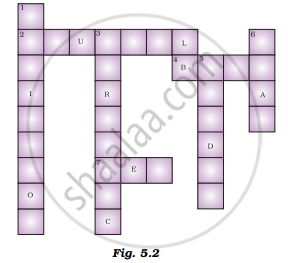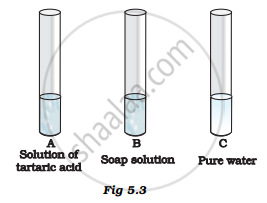Advertisements
Online Mock Tests
Chapters
2: Nutrition in Animals
3: Fibre to Fabric
4: Heat
▶ 5: Acids, Bases and Salts
6: Physical and Chemical Changes
7: Weather, Climate and Adaptation of Animals to Climate
8: Wind, Storm and Cyclone
9: Soil
10: Respiration in Organisms
11: Transportation in Animals and Plants
12: Reproduction in Plants
13: Motion and Time
14: Electric Current and Its Effects
15: Light
16: Water : A Precious Resource
17: Forests : Our Lifeline
18: Wastewater Story
![NCERT Exemplar solutions for Science [English] Class 7 chapter 5 - Acids, Bases and Salts NCERT Exemplar solutions for Science [English] Class 7 chapter 5 - Acids, Bases and Salts - Shaalaa.com](/images/science-english-class-7_6:5f2b1b2038084cf381bfa42c826a928c.jpg)
Advertisements
Solutions for Chapter 5: Acids, Bases and Salts
Below listed, you can find solutions for Chapter 5 of CBSE NCERT Exemplar for Science [English] Class 7.
NCERT Exemplar solutions for Science [English] Class 7 5 Acids, Bases and Salts MULTIPLE CHOICE QUESTIONS [Pages 27 - 28]
The correct way of making a solution of acid in water is to
add water to acid.
add acid to water.
mix acid and water simultaneously
add water to acid in a shallow container.
Products of a neutralisation reaction are always
an acid and a base
an acid and a salt
a salt and water
a salt and a base
Turmeric is a natural indicator. On adding its paste to acid and base separately, which colours would be observed
Yellow in both acid and base
Yellow in acid and red in the base
Pink in acid and yellow in base
Red in acid and blue in base
Phenolphthalein is a synthetic indicator and its colours in acidic and basic solutions, respectively are
red and blue
blue and red
pink and colourless
colourless and pink
When the soil is too basic, plants do not grow well in it. To improve its quality what must be added to the soil?
Organic matter
Quick lime
Slaked lime
Calamine solution
‘Litmus’, a natural dye is an extract of which of the following?
China rose (Gudhal)
Beetroot
Lichen
Blueberries (Jamun)
A neutralisation reaction is a
physical and reversible change
a physical change that cannot be reversed
chemical and reversible change
the chemical change that cannot be reversed
A solution changes the colour of the turmeric indicator from yellow to red. The solution is
basic
acidic
neutral
either neutral or acidic
Which of the following set of substances contain acids?
Grapes, lime water
Vinegar, soap
Curd, milk of magnesia
Curd, vinegar
On adding phenolphthalein indicator to a colourless solution, no change is observed. What is the nature of this solution?
Basic
Either acidic or basic
Either acidic or neutral
Either basic or neutral
Which of the following is an acid-base indicator?
Vinegar
Lime water
Turmeric
Baking soda
NCERT Exemplar solutions for Science [English] Class 7 5 Acids, Bases and Salts VERY SHORT ANSWER QUESTIONS [Page 29]
Look at the given reaction.
Hydrochloric acid + Sodium hydroxide (base) → Sodium chloride (salt) + Water
Sodium chloride formed in this reaction remains in
solution form. Can we get solid sodium chloride from this solution? Suggest a method (if any).
State whether the following statements are true or false. Correct the false statements.
All substances are either acidic or basic.
True
False
State whether the following statements are true or false. Correct the false statements.
A compound if acidic will turn all indicators red.
True
False
State whether the following statements are true or false. Correct the false statements.
Lime water turns red litmus blue.
True
False
State whether the following statements are true or false. Correct the false statements.
Common salt dissolved in water turns blue litmus red.
True
False
State whether the following statements are true or false. Correct the false statements.
Phenolphthalein is a natural indicator.
True
False
State whether the following statements are true or false. Correct the false statements.
Calamine can be used to treat ant stings.
True
False
State whether the following statements are true or false. Correct the false statements.
Lemon water is basic in nature.
True
False
Paheli is suffering from indigestion due to acidity. Is it advisable to give her orange juice in this situation and why?
NCERT Exemplar solutions for Science [English] Class 7 5 Acids, Bases and Salts SHORT ANSWER QUESTIONS [Pages 29 - 30]
Look at Figure 5.1 which shows solutions taken in test tubes A, B, C and D. What colour is expected when a piece of red litmus paper is dropped in each test tube? The nature of the solutions is given in the table for your help.

| Test tube | Nature of Solution | Change in colour of red litmus |
| A | Neutral | |
| B | Basic | |
| C | Acidic | |
| D | Neutral |
While playing in a park, a child was stung by a wasp. Some elders suggested applying a paste of baking soda and others lemon juice as a remedy. Which remedy do you think is appropriate and why?
Form a sentence using the following words – baking soda, ant bite, moist, effect, neutralised, rubbing.
Match the substances in Column I with those in Column II.
| Column 1 | Column II | ||
| (a) | Tartaric acid | (i) | soap |
| (b) | Calcium hydroxide | (ii) | curd |
| (c) | Formic acid | (iii) | unripe mangoes |
| (d) | Sodium hydroxide | (iv) | ant’s sting |
| (e) | Lactic acid | (v) | lime water |
Fill the blanks in the following sentences
Lemon juice and vinegar taste ___________ because they contain ___________.
Turmeric and litmus are _________ acid-base indicators.
Phenolphthalein gives _________ colour with lime water.
When an acidic solution is mixed with a basic solution, they _________ each other forming _________ and water.
NCERT Exemplar solutions for Science [English] Class 7 5 Acids, Bases and Salts LONG ANSWER QUESTIONS [Page 31]
Boojho, Paheli and their friend Golu were provided with a test tube each containing China rose solution which was pink in colour. Boojho added two drops of solution ‘A’ in his test tube and got dark pink colour. Paheli added 2 drops of solution ‘B’ to her test tube and got green colour. Golu added 2 drops of solution ‘C’ but could not get any change in colour. Suggest the possible cause for the variation in their results.
Fill in the crossword given in Figure 5.2 with the help of the clues provided.

Across
(2) The solution which does not change the colour of either red or blue litmus.
(4) Phenolphthalein gives pink colour in this type of solution.
(7) Colour of blue litmus in lemon juice.
Down
(1) It is used to test whether a substance is acidic or basic.
(3) It is a natural indicator and gives pink colour to the basic solution.
(5) Nature of ant’s sting.
(6) It is responsible for the increase in temperature during a neutralisation reaction.
A farmer was unhappy because of his low crop yield. He discussed the problem with an agricultural scientist and realised that the soil of his field was either too acidic or too basic. What remedy would you suggest to the farmer to neutralise the soil?
You are provided with four test tubes containing sugar solution, baking soda solution, tamarind solution, and salt solution. Write down the activity to find the nature (acidic/basic/neutral) of each solution.
You are provided with three test tubes A, B and C as shown in Figure 5.3 with different liquids. What will you observe when you put
- a piece of blue litmus paper in each test tube.
- a piece of red litmus paper in each test tube.
- a few drops of phenolphthalein solution to each test tube.

Paheli observed that most of the fish in the pond of her village were gradually dying. She also observed that the waste of a factory in their village is flowing into the pond which probably caused the fish to die.
(a) Explain why the fish were dying.
(b) If the factory waste is acidic in nature, how can it be neutralised?
Explain two neutralisation reactions related to daily life situations.
Solutions for 5: Acids, Bases and Salts
![NCERT Exemplar solutions for Science [English] Class 7 chapter 5 - Acids, Bases and Salts NCERT Exemplar solutions for Science [English] Class 7 chapter 5 - Acids, Bases and Salts - Shaalaa.com](/images/science-english-class-7_6:5f2b1b2038084cf381bfa42c826a928c.jpg)
NCERT Exemplar solutions for Science [English] Class 7 chapter 5 - Acids, Bases and Salts
Shaalaa.com has the CBSE Mathematics Science [English] Class 7 CBSE solutions in a manner that help students grasp basic concepts better and faster. The detailed, step-by-step solutions will help you understand the concepts better and clarify any confusion. NCERT Exemplar solutions for Mathematics Science [English] Class 7 CBSE 5 (Acids, Bases and Salts) include all questions with answers and detailed explanations. This will clear students' doubts about questions and improve their application skills while preparing for board exams.
Further, we at Shaalaa.com provide such solutions so students can prepare for written exams. NCERT Exemplar textbook solutions can be a core help for self-study and provide excellent self-help guidance for students.
Concepts covered in Science [English] Class 7 chapter 5 Acids, Bases and Salts are Acids, Indicators, Types of Double Displacement: Neutralization Reaction, Neutralization Reactions in Our Daily Life, Bases (Alkalis), Similarities and Differences Between Acids and Bases.
Using NCERT Exemplar Science [English] Class 7 solutions Acids, Bases and Salts exercise by students is an easy way to prepare for the exams, as they involve solutions arranged chapter-wise and also page-wise. The questions involved in NCERT Exemplar Solutions are essential questions that can be asked in the final exam. Maximum CBSE Science [English] Class 7 students prefer NCERT Exemplar Textbook Solutions to score more in exams.
Get the free view of Chapter 5, Acids, Bases and Salts Science [English] Class 7 additional questions for Mathematics Science [English] Class 7 CBSE, and you can use Shaalaa.com to keep it handy for your exam preparation.
